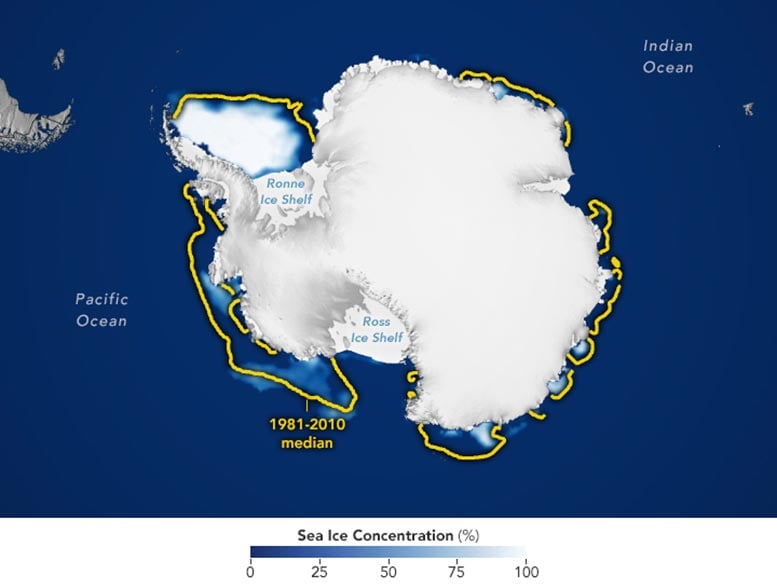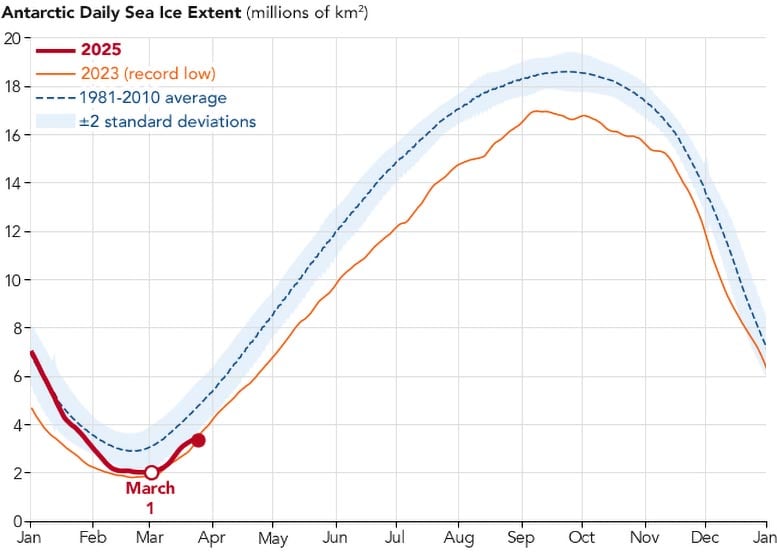
Antarctica’s summer sea ice has dropped to one of its lowest extents ever recorded, shrinking to levels 30% below the historical average.
Scientists are unsure whether this marks a new long-term trend or a temporary fluctuation. Using satellite data that spans nearly five decades, researchers are tracking dramatic global losses in sea ice, including in the Arctic, where winter coverage is also near record lows. Altogether, the planet has lost an area of sea ice equivalent to the size of the eastern United States.
Antarctic Sea Ice Hits Historic Low
In the summer of 2025, Antarctic sea ice reached one of its lowest levels on record, tying for the second-lowest minimum extent in 47 years of satellite observations, according to NASA and the National Snow and Ice Data Center (NSIDC).
On March 1, 2025, the annual summer low, sea ice coverage dropped to 1.98 million square kilometers (764,000 square miles) as shown in the map above. That’s about 30 percent below the 1981–2010 average of 2.84 million square kilometers (1.10 million square miles).
How Scientists Define and Track Sea Ice
Scientists define sea ice extent as the total area where at least 15 percent of the surface is covered by ice. The yellow line on the map represents the median ice extent for February from 1981 to 2010, meaning half of the recorded extents during that period were larger than the line, and half were smaller.
“It’s not yet clear whether the Southern Hemisphere has entered a new norm with perennially low ice or if the Antarctic is in a passing phase that will revert to prior levels in the years to come,” said Walt Meier, an ice scientist with NSIDC.
Satellites Reveal Long-Term Ice Trends
For their analysis, scientists primarily rely on satellites in the Defense Meteorological Satellite Program (DMSP), which measure Earth’s radiation in the microwave range. This natural radiation is different for open water and for sea ice—with ice cover standing out brightly in microwave-based satellite images. Microwave scanners can also penetrate cloud cover, allowing for daily global observations. The DMSP data are augmented with historical sources, including data collected between 1978 and 1985 with the Nimbus-7 satellite that was jointly operated by NASA and the National Oceanic and Atmospheric Administration.
Global Ice Coverage in Rapid Decline
As sea ice in the Antarctic reached its summer low, sea ice across the Arctic was approaching the lowest winter extent ever observed in the satellite record. Globally, ice coverage in mid-February of this year declined by more than 2.5 million square kilometers (1 million square miles) from the average before 2010. Altogether, Earth is missing an area of sea ice large enough to cover the entire continental United States east of the Mississippi.
NASA Earth Observatory images by Lauren Dauphin, using data from the National Snow and Ice Data Center. Story by James R. Riordon/NASA’s Earth Science News Team, adapted for Earth Observatory by Kathryn Hansen.
Never miss a breakthrough: Join the SciTechDaily newsletter.

4 Comments
Wonderful news. More moisture in the atmosphere may green up deserts and more fresh water in the oceans keeps them from getting too salty. Good times ahead.
“Antarctica’s summer sea ice has dropped to ONE of its lowest extents ever recorded, …”
Wake me when we get to the lowest extent again. Even the NASA website remarks that the Antarctic ice shelves are highly variable.
Great news. I hate the cold and Antarctica has some valuable land underneath all that ice.
Excellent! The less Sea Ice the more moisture and the more snow on the Antarctica.
Btw The latest value from a graph from NCDS shows that there are well over 300 Gigatonnes new snow on Antarctica, and the mass balance there is over 200 Gigatonnes. The Sea ICE mass is 1/100 or less that 2 Gigatonnes (in March 2025 Sea ice was 1 Gigatonnes, that is 1/200).
https://nsidc.org/ice-sheets-today/analyses/antarctic-ice-sheet-2024-2025-melt-season-fast-start-early-end